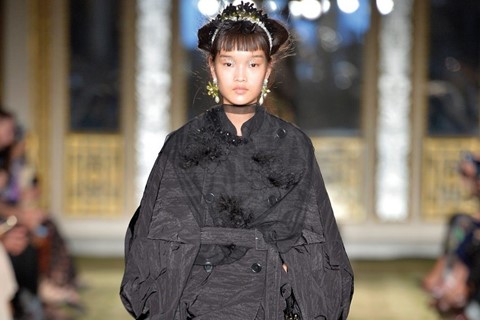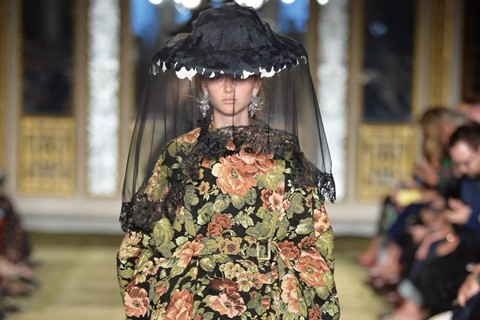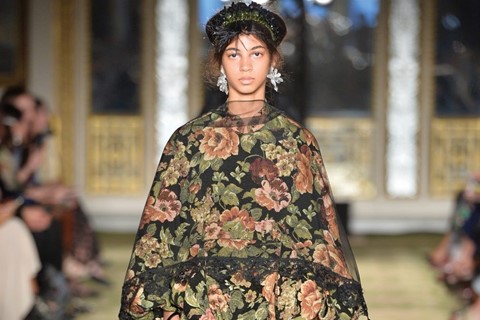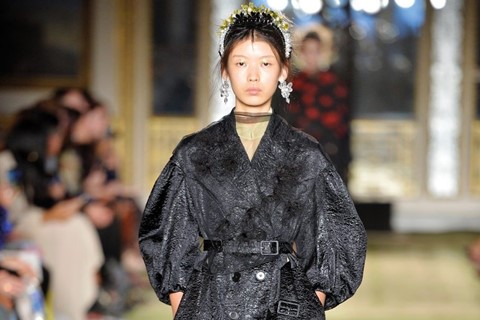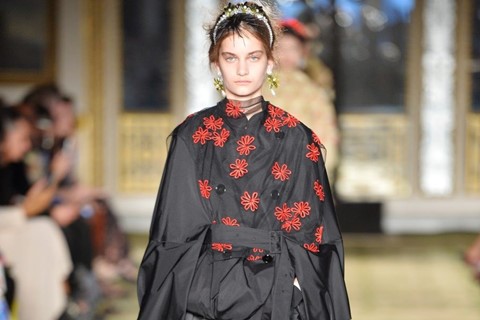In 1848 at Stafford House, St James, London, Frédéric Chopin performed a piano recital for Queen Victoria. “I have come from my house to your palace,” the Queen told the Duchess of Sutherland, the house’s then-owner, responsible for its baroque Louis XIV-style decor and the sweeping Grand Hall. Of that same evening and abode, the composer wrote to his family: “The staircases are famous for their magnificence ... On these stairs one could see the Queen, under a brilliant light, surrounded by all sorts of bediamonded and beribboned people with the Garter, and all descending with the utmost elegance, carrying on conversations...”
Commissioned in 1825 for the Duke of York and Albany, the Georgian mansion has since seen several monikers and monarchs. But in September 2018, several of the staterooms on the piano nobile – the first floor – played host to Simone Rocha’s Spring/Summer 2019 catwalk show. Today, Lancaster House, as it is now known, is used by the Foreign and Commonwealth Office for official functions and receptions. It is accessible to the public only on rare open days and on those dates in February and September when Rocha has opened its doors to fashion editors, buyers, family friends. On such occasions, she has shown, among other things, cotton petticoats cinched with holster-like harnesses, 40s-style faux-fur stoles and militaristic velvet coats (Autumn/Winter 2017); 19th-century puffed sleeves, empire-line smocks and ribbon-embroidered dresses inspired by Constable portraiture (Autumn/Winter 2018); and hats veiled with embroidered tulle and lace, pearl-bead studded tiaras and images of Tang-dynasty concubines printed onto tapestry dresses (Spring/Summer 2019).
“Deep down I’m quite traditional,” Rocha explains from her desk, a black expanse of lacquered wood backed by a ceiling-height bookshelf heavy with art tomes: Francis Bacon, Louise Bourgeois, Michaël Borremans, Picasso. Touchstones of modernism, cubism, surrealism and abstract expressionism. Sex and death permeate their work, and touch hers, too, intriguingly mixed with a prettiness that never cloys. Those artists, like the vast concrete unit that houses the Simone Rocha showroom in London’s De Beauvoir, are the antithesis of Lancaster House’s stately pleasures. But that dichotomy marks Rocha’s output. “I’m attracted to traditionally feminine things but looking at them through the guise of today, of reality. Such as pearls – they have become a signature in my work – they’re so ‘old lady’, but I love to reinterpret them,” she continues. Her other signatures: tufted tulle party dresses scissored about the body; plain cotton shirting; twisted trench coats; heavy-soled brogues; a bulbousness (padded pouches, bulging pockets) that avoids being cumbersome, which is perhaps because a woman is designing these garments and knows what it’s like to wear them. Combined with her pearly-queen crowns and hair clips, these read as abstracted courtly clothes, as princess dressing for today.
The Tang-dynasty faces peering from Rocha’s offerings this season echo a blend of sex and nobility that has earned her a loyal following. That nod to the Chinese empire of the 7th to 10th centuries also alludes to her own dynasty – the one built by her father, the Hong Kong-born fashion designer John Rocha. Her mother, Odette, born in Dublin, where Simone also grew up, has been pivotal as a business partner first to her husband and now her daughter. Despite burgeoning success and standalone stores in London’s Mount Street and SoHo, New York, Simone’s business is very much a family affair and she remains ferociously independent. Known in the 1990s for his own tulle confections, hand-beading and intricate appliqué, an aesthetic that has since trickled down from his catwalk to the high street via sister lines and collaborations, Rocha senior won Designer of the Year at the British Fashion Awards in 1993. In 2016, Simone received the same honour for womenswear.

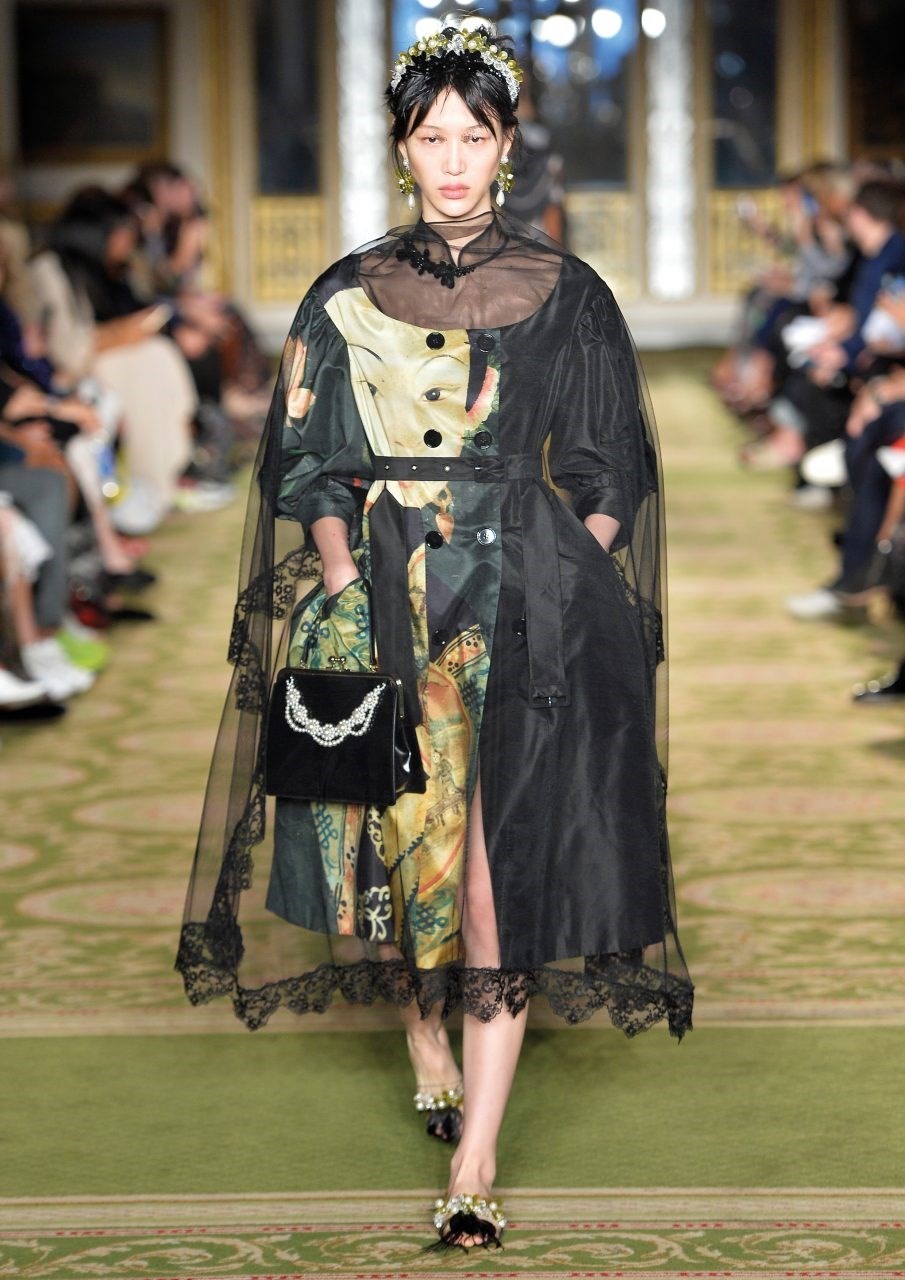
Growing up, Rocha spent her holidays helping in her father’s studios: “I was annoying everybody, like, ‘Ooh, can I do a job?’, because I was not really into school when I was young, but I loved working. I loved being a waitress – I loved the practicality of working.” And it was in her father’s studio that she learned to crochet – for the socks, for one of his shows – a craft that has appeared in myriad forms in her independent work, where folksy Irish methods of handwork recur, a constant reminder of her roots. Rocha happily skipped school to attend her father’s shows at London Fashion Week; fashion, and the rituals that surround it, have coursed through the Rocha household for as long as she can remember. A key memory that has been percolating for decades (“I think I was five or six”) is of attending her parents’ wedding. Her father made everyone’s dresses, including Odette’s. “It was rose, tea stained and all hand-painted. In the evening she wore a mini dress covered in pearls,” Rocha says. Her own designs have been ceremonial since the off. Funereal, bridal, baptismal: uniforms of the milestones in a woman’s life appear continuously through Rocha’s love of black lace, smocked cottons, ruffled white silk, veils. Even her Central Saint Martins MA collection in February 2010 dealt with mourning garb, especially that worn by the women of the Aran Islands. “When someone dies, the women go into mourning and dye their petticoats red, but they wear them on their heads – that’s how veils were interpreted,” Rocha explains. “I love how human, personal feelings can translate into dress, and then how that dress affects the garment itself or how it’s worn.” Like fellow Central Saint Martins alumni Kim Jones, Christopher Kane and Craig Green, Rocha studied under the late Louise Wilson. Here, Rocha’s fashion heritage gave her no head start. “She was really tough on me. She would just ignore me. I was like, ‘Just tell me I’m shit!’ But I’d get nothing. She knew exactly how to play it, she knew how to get the best out of her students – that was her absolute power.” Wilson hammered home the importance of channelling your own individualism. “She would say, ‘It’s your identity, and it’s something that is signature to you because you have to live with it.’”
Visibly, Rocha’s identity is woven into each garment. For Autumn/Winter 2016, a collection created one month after she’d given birth to her daughter, Valentine, coats and dresses were lumpy, roomy, torn and distressed; pink and yellow coats were matronly; red crystal drop earrings trickled like blood; stoles were swaddled around the body. This entwinement of life and work is in no small part responsible for the engagement the brand has seen in stores such as Dover Street Market in London and Ginza, Ikram in Chicago, and 10 Corso Como in Milan and Seoul, as well as the broad age range that visits her namesake boutiques. An ongoing collaboration with Moncler offers further proof of Rocha’s appeal – an opportunity to write her hyper-feminine idiosyncrasies onto the perhaps unlikely canvas of Moncler’s technical sportswear. It might seem an incongruous approach, attempting to engage others by visually talking about oneself, but it works and always has.

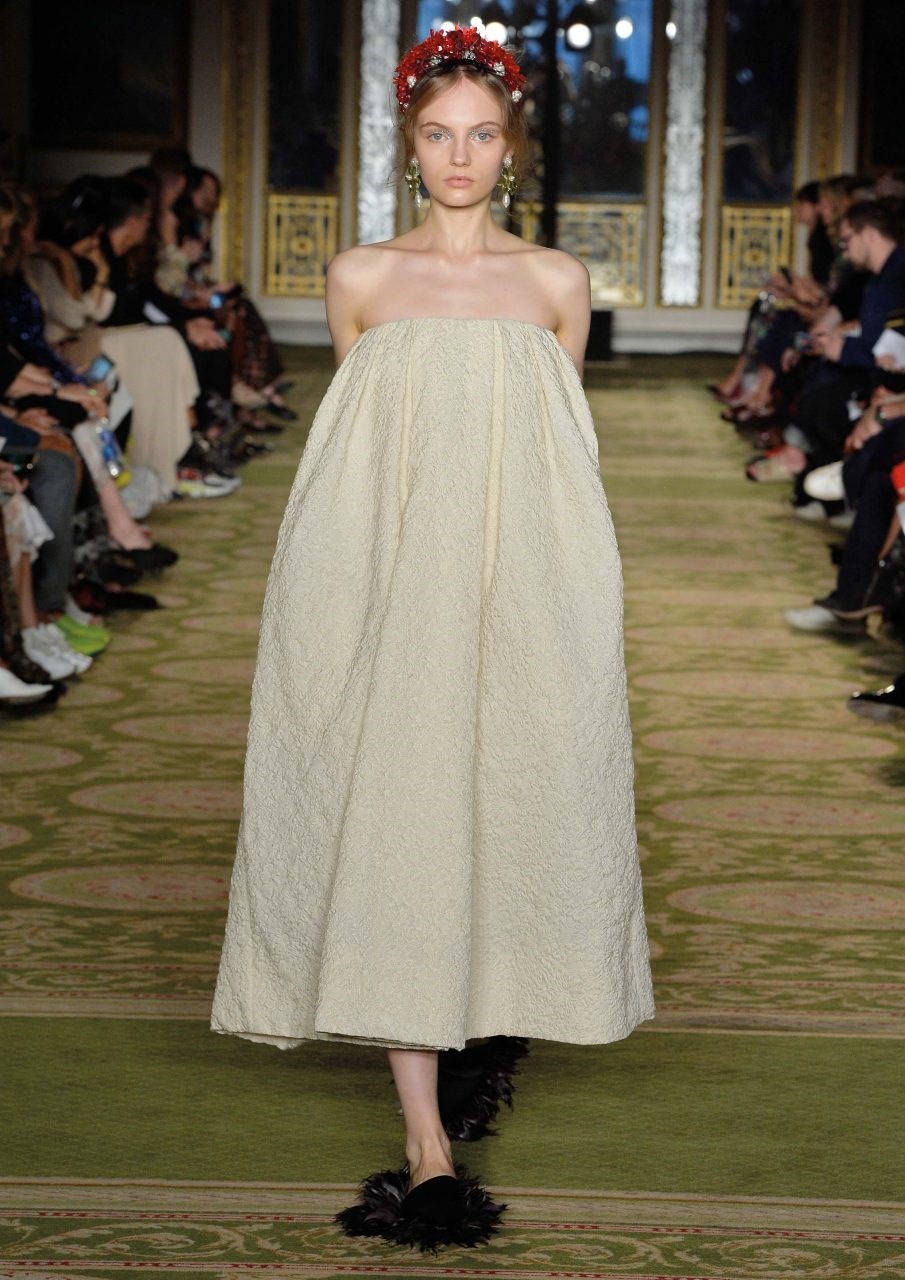
“I think it makes the work stronger,” Rocha says of her autobiographical slant. “Because I feel like if I expose some of myself, if it’s something personal, I’m more immersed in it. I can pull more out of the narrative to give the whole process more weight.” The all-female design team bustle about the studio as living proof of that: chunky knits, poplin shirts, overblown skirts, trainers kicked off under desks in exchange for furry mules. “I really hate when something’s disposable. I find it so wasteful. Wasteful not only of creativity, and time and effort, but for whoever’s invested in that. I admire Rei Kawakubo, or Rick Owens – they create a dialogue that grows and moves.”
Dazed magazine’s creative director, Robbie Spencer, has been working with the brand, styling the shows since that same postnatal presentation, and remembers when Rocha came to do an internship at the magazine about 11 years ago. “Simone has such integrity – she never tries to do anything other than Simone Rocha. In an industry where originality and consistency is so hard to find, you can see why Simone has such a loyal following and so much support – it’s not just a brand, it’s a community of like-minded people.”
It is a sense of fusion, not contrast, that underpins the Simone Rocha brand – practicality and femininity, tradition and functionality. Wilson attended every one of Rocha’s shows before she died and, when asked, described the designer’s aesthetic as a “strong, modern femininity”. Rewriting the time-worn heritage of womenswear, Rocha invites women today to be both powerful and feminine at once.
Hair: Alexander Soltermann using Oribe. Make-up: Siddhartha Simone at Julian Watson Agency. Model: Ilona Desmet at Girl Management. Casting: Simone Schofer. Set design: Thomas Bird at Bryant Artists. Manicure: Saffron Goddard at Saint Luke Artists using Le Gel Top Coat and La Crème Main Texture Riche by Chanel. Digital tech: Daniel Archer at Dtouch London. Lighting: Emma Ercolani and Ibby Azab. Styling assistant: Isobel Attrill. Make-up assistant: Asuka Fukuda. Production: Webber, Vinita Davé and Nathan Kerry Davé. Post-production: Dtouch London
This story originally featured in the Spring/Summer 2019 issue of AnOther Magazine which is on sale internationally now.

